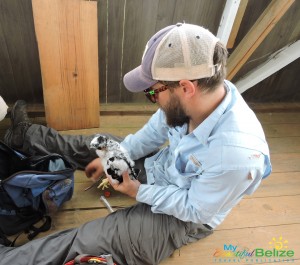 The country of Belize is blessed with some of the most amazing animals on the planet, and in some instances, we are the last place on Earth where they survive and thrive. Although they may seem abundant to us, our small country is home to a number of amphibians, birds, fish, mammals, reptiles, plants and even corals that are at risk of extinction; perilously registered on the International Union for Conservation of Nature (IUCN) Red List. From near-threatened to critically endangered, animals like the American Crocodile, Hicatee turtle, Yellow-headed Amazon parrot, Orange-breasted Falcon, West Indian manatee and countless others, Belize is their last stronghold for survival. Fortunately, our country is also blessed with a number of non-profit conservation groups that are dedicated to their preservation. Local organizations like Wild Tracks, Belize Bird Rescue, American Crocodile Education Sanctuary, Belize Foundation for Research & Environmental Education, Friends for Conservation & Development, Community Baboon Sanctuary, Belize Wildlife and Referral Clinic, Belize Bird Conservancy, Belize Raptor Center, Belize Audubon, MarAlliance and the Scarlet Six Biomonitoring Team, (to name a few), along with a handful of international organizations like Oceana, World Wildlife Fund, the Wildlife Conservation Society, The Nature Conservancy, and Cornell Laboratory of Ornithology, are all doing their part to conserve, protect, rescue, rehabilitate and educate the community about these at-risk species. One international organization, The Peregrine Fund has taken conservation efforts of the endangered Orange-breasted Falcon (OBF) to a whole new level, with an unprecedented restoration project with captive-breed birds propagated in the USA and wild-releasing them in the Mountain Pine Ridge region of Belize.
The country of Belize is blessed with some of the most amazing animals on the planet, and in some instances, we are the last place on Earth where they survive and thrive. Although they may seem abundant to us, our small country is home to a number of amphibians, birds, fish, mammals, reptiles, plants and even corals that are at risk of extinction; perilously registered on the International Union for Conservation of Nature (IUCN) Red List. From near-threatened to critically endangered, animals like the American Crocodile, Hicatee turtle, Yellow-headed Amazon parrot, Orange-breasted Falcon, West Indian manatee and countless others, Belize is their last stronghold for survival. Fortunately, our country is also blessed with a number of non-profit conservation groups that are dedicated to their preservation. Local organizations like Wild Tracks, Belize Bird Rescue, American Crocodile Education Sanctuary, Belize Foundation for Research & Environmental Education, Friends for Conservation & Development, Community Baboon Sanctuary, Belize Wildlife and Referral Clinic, Belize Bird Conservancy, Belize Raptor Center, Belize Audubon, MarAlliance and the Scarlet Six Biomonitoring Team, (to name a few), along with a handful of international organizations like Oceana, World Wildlife Fund, the Wildlife Conservation Society, The Nature Conservancy, and Cornell Laboratory of Ornithology, are all doing their part to conserve, protect, rescue, rehabilitate and educate the community about these at-risk species. One international organization, The Peregrine Fund has taken conservation efforts of the endangered Orange-breasted Falcon (OBF) to a whole new level, with an unprecedented restoration project with captive-breed birds propagated in the USA and wild-releasing them in the Mountain Pine Ridge region of Belize. Research on the Orange-breasted falcon began 25 years ago when graduate student Aaron Baker initiated the first ever natural-history study of the species in Belize and bordering Guatemala, now known to be the same contiguous population. That same year Robert Berry, Founding Director of the Peregrine Fund and Founder of the North American Raptor Breeders’ Association and an expert in falcon breeding visited with Baker in Belize to add his knowledge to Barker’s research. It was Berry’s first encounter with the little known tropical falcon, elusive and rare throughout its wide range. The experience was the beginning of a life-long relationship that few would ever have imagined. After six years of research, Baker concluded that the small population of Orange-breasted Falcons was probably stable, but just barely!
Research on the Orange-breasted falcon began 25 years ago when graduate student Aaron Baker initiated the first ever natural-history study of the species in Belize and bordering Guatemala, now known to be the same contiguous population. That same year Robert Berry, Founding Director of the Peregrine Fund and Founder of the North American Raptor Breeders’ Association and an expert in falcon breeding visited with Baker in Belize to add his knowledge to Barker’s research. It was Berry’s first encounter with the little known tropical falcon, elusive and rare throughout its wide range. The experience was the beginning of a life-long relationship that few would ever have imagined. After six years of research, Baker concluded that the small population of Orange-breasted Falcons was probably stable, but just barely!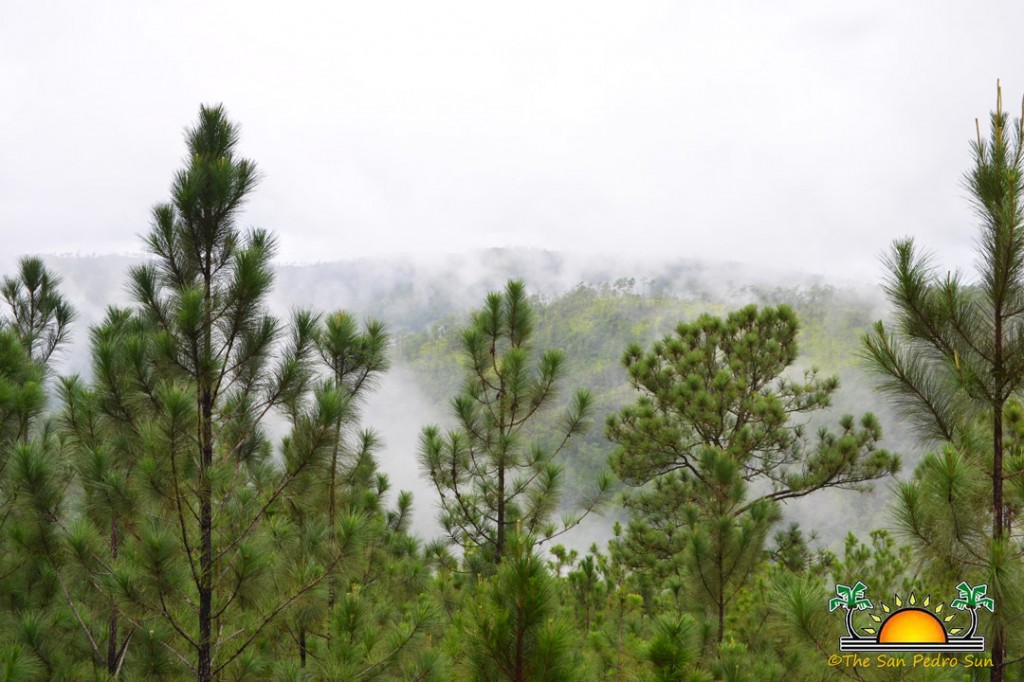 Under Berry’s direction, The Peregrine Fund resumed surveys in 2003, with yearly expeditions on the ground and in the air, traversing through rugged, remote areas of dense, tropical forests in extreme heat, scaling up or rappelling down cliffs in search of or to assess and color band OBF chicks on rocky nesting spots and even surviving attacks from Africanized bees. Their research concluded that Baker’s study population of 19 nesting territories was in steep decline, with nearly half his study territories (cliff nest sites called “eyries” by scientists) abandoned with only ten remaining. Based upon study specimens in the world’s museums collected between 1867-1962, the OBF was sparsely populated throughout much of Central America, but is now nearly extirpated, perhaps the victim of DDT, the ravages of tropical hurricanes, or human conflicts, with the remaining population of less than 20 territorial pairs limited to only 4% of its prior range in Belize and Guatemala and isolated by some 1,500 kilometers from the few remaining pairs on the Columbian border of Panama.
Under Berry’s direction, The Peregrine Fund resumed surveys in 2003, with yearly expeditions on the ground and in the air, traversing through rugged, remote areas of dense, tropical forests in extreme heat, scaling up or rappelling down cliffs in search of or to assess and color band OBF chicks on rocky nesting spots and even surviving attacks from Africanized bees. Their research concluded that Baker’s study population of 19 nesting territories was in steep decline, with nearly half his study territories (cliff nest sites called “eyries” by scientists) abandoned with only ten remaining. Based upon study specimens in the world’s museums collected between 1867-1962, the OBF was sparsely populated throughout much of Central America, but is now nearly extirpated, perhaps the victim of DDT, the ravages of tropical hurricanes, or human conflicts, with the remaining population of less than 20 territorial pairs limited to only 4% of its prior range in Belize and Guatemala and isolated by some 1,500 kilometers from the few remaining pairs on the Columbian border of Panama.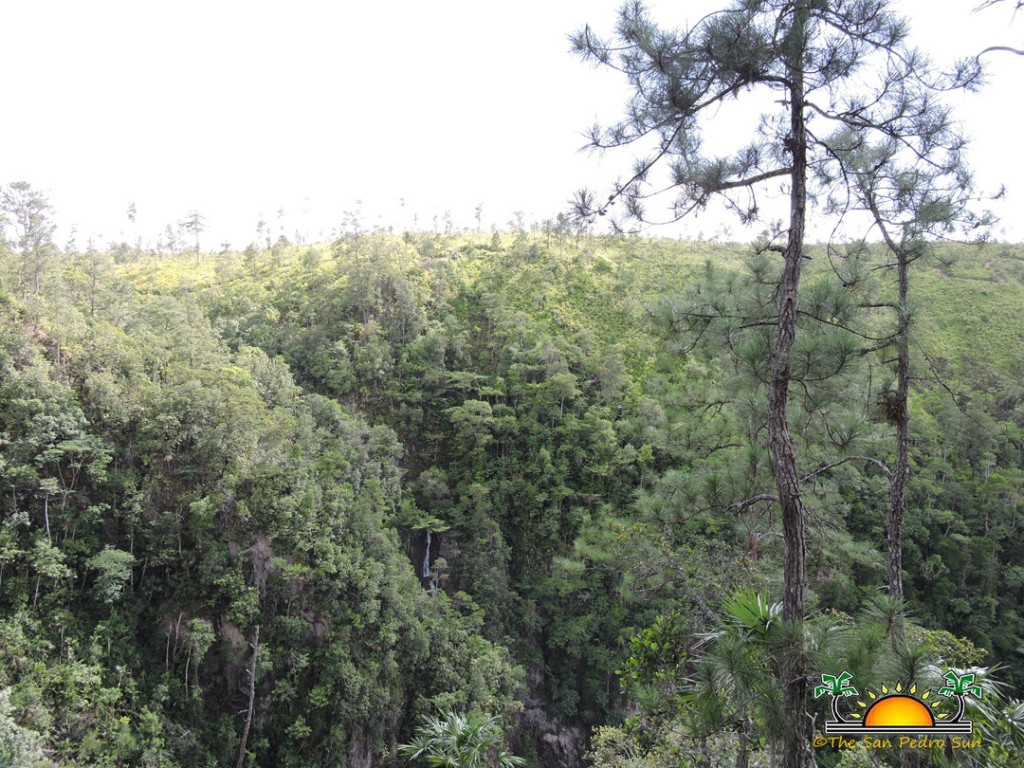 Berry’s crew have discovered a few more sporadically occupied territories in the foothills of the Southern Maya Mountains once thought the stronghold for the species. Helicopter surveys in 2017 of the inaccessible interior mountains revealed a sharp decline to only three occupied eyries where ten were discovered in 2010. Over time, the team accepted the sad truth that the entire northern population was rapidly losing their stronghold due to low and inconsistent productivity, and a variety of natural and human-caused perils such as habitat alteration, fragmentation, human conflicts, hunting, natural predation from mammals, snakes vultures and hawk eagles as well as parasitism from bot-fly larva. Early on The Peregrine Fund had saved the imperiled American Peregrine Falcon that had been decimated by DDT contamination of its food source and had successfully reintroduced the extinct Aplomado Falcon to south Texas, so why not the Orange-breasted Falcon? OBF eggs were collected from unrelated breeding stock in Panama in 2001-2002 which formed the nucleus of an experimental breeding colony originally split between Panama and Berry’s facilities in Wyoming. Because of his passion for the OBF and extensive experience with other raptor species, all of the birds were soon relocated to Wyoming, with first successful breeding in 2006.
Berry’s crew have discovered a few more sporadically occupied territories in the foothills of the Southern Maya Mountains once thought the stronghold for the species. Helicopter surveys in 2017 of the inaccessible interior mountains revealed a sharp decline to only three occupied eyries where ten were discovered in 2010. Over time, the team accepted the sad truth that the entire northern population was rapidly losing their stronghold due to low and inconsistent productivity, and a variety of natural and human-caused perils such as habitat alteration, fragmentation, human conflicts, hunting, natural predation from mammals, snakes vultures and hawk eagles as well as parasitism from bot-fly larva. Early on The Peregrine Fund had saved the imperiled American Peregrine Falcon that had been decimated by DDT contamination of its food source and had successfully reintroduced the extinct Aplomado Falcon to south Texas, so why not the Orange-breasted Falcon? OBF eggs were collected from unrelated breeding stock in Panama in 2001-2002 which formed the nucleus of an experimental breeding colony originally split between Panama and Berry’s facilities in Wyoming. Because of his passion for the OBF and extensive experience with other raptor species, all of the birds were soon relocated to Wyoming, with first successful breeding in 2006. 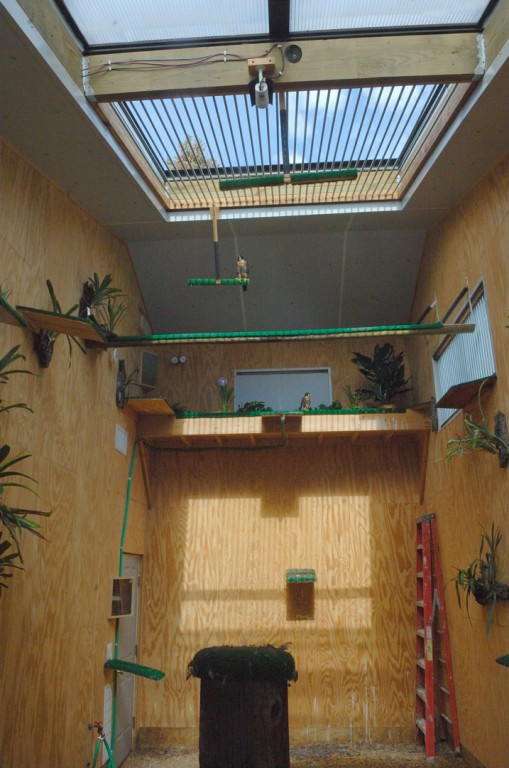 Unlike most hawk and falcon species which readily breed in captivity, and despite large elaborate climate controlled facilities, the OBF seemingly adapted well to captivity and displayed extensive courtship rituals, nonetheless, they would not mate in captivity. All eggs have been fertilized by artificial insemination, a stressful process where the semen is stripped forcefully from the male and placed into the manually everted oviduct of the female, a traumatic experience for both the Falcons and the perpetrator/ breeder. The breeding colony currently consists of 29 birds; most of the original founders from Panama, a few from Belize (including two botfly-infested juveniles that were rescued from certain death in 2012), and their captive-bred progeny. Incredibly, the project has successfully introduced 50 captive-bred Orange-breasted Falcons into the Mountain Pine Ridge area of Belize since 2007. Only three have bonded successfully with wild mates raising and fledging ten youngsters into the wild population, a seemingly meager number but huge considering the small population. This degree of success was only dreamed about by a similar but unsuccessful effort to restore the Harpy Eagle in the Yalbac of northern Belize a decade ago. The eagles emigrated widely and were shot for a variety of reasons, mostly due to the cultural belief that large predators and raptors are threats to humans and livestock.
Unlike most hawk and falcon species which readily breed in captivity, and despite large elaborate climate controlled facilities, the OBF seemingly adapted well to captivity and displayed extensive courtship rituals, nonetheless, they would not mate in captivity. All eggs have been fertilized by artificial insemination, a stressful process where the semen is stripped forcefully from the male and placed into the manually everted oviduct of the female, a traumatic experience for both the Falcons and the perpetrator/ breeder. The breeding colony currently consists of 29 birds; most of the original founders from Panama, a few from Belize (including two botfly-infested juveniles that were rescued from certain death in 2012), and their captive-bred progeny. Incredibly, the project has successfully introduced 50 captive-bred Orange-breasted Falcons into the Mountain Pine Ridge area of Belize since 2007. Only three have bonded successfully with wild mates raising and fledging ten youngsters into the wild population, a seemingly meager number but huge considering the small population. This degree of success was only dreamed about by a similar but unsuccessful effort to restore the Harpy Eagle in the Yalbac of northern Belize a decade ago. The eagles emigrated widely and were shot for a variety of reasons, mostly due to the cultural belief that large predators and raptors are threats to humans and livestock.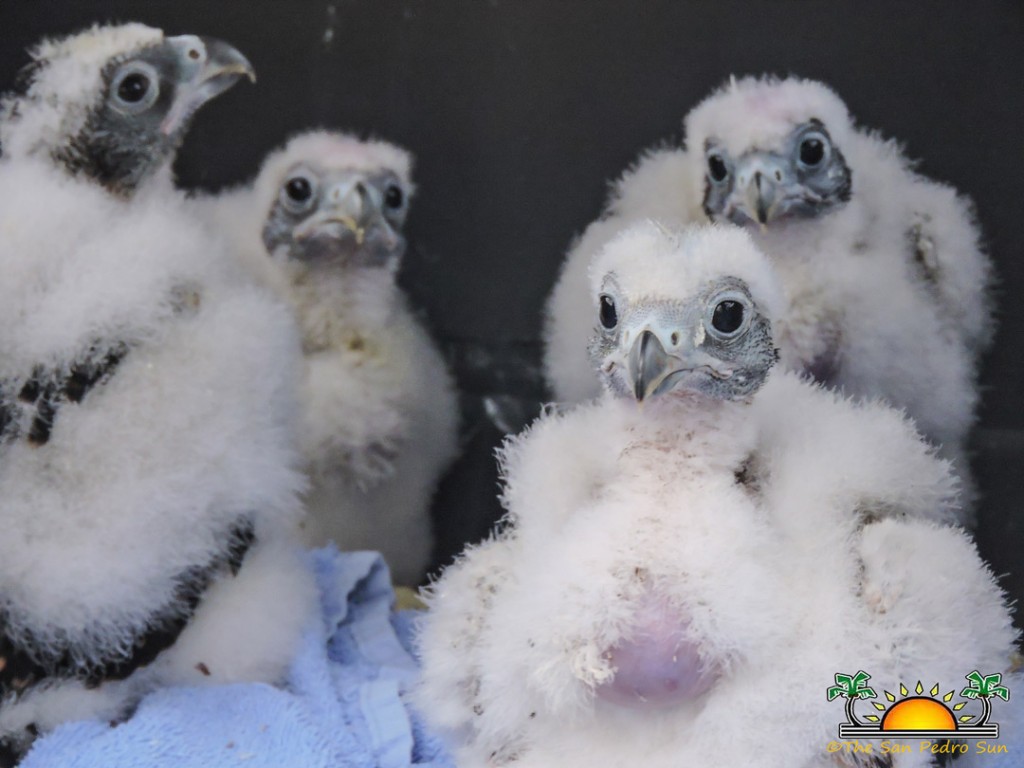 In June 2017, the OBF team added four chicks, three females and one male, to the dwindling population. When the captive-bred chicks are about 40 days old, Berry and some 800-fresh killed and frozen Coturnix quail that he raises under controlled conditions as food for the juveniles in the coming months are flown to Belize via a donated private charter as the cargo is too precious for commercial airlines to consider. Starting in northern Wyoming, it’s a 12-hour travel day, with a stop in Houston, Texas for a thorough vetting of the many permits required to transport both the quail and falcons. Obtaining the necessary paperwork is a lengthy process, and involves collaborating with many agencies, including the U.S. Fish and Wildlife Service, the Wyoming Game and Fish Department, state, national, and international veterinarians, U.S. Diagnostic and Testing Laboratory, Belize Forest Department, and Belize Animal Health Administration. Most importantly, multiple molecular diagnostic test results are examined and duplicated in both the U.S. and Belize to make certain that no pathogenic diseases are imported. Once they arrive in Belize, Berry is meet by Matt Allshouse, Lead Field Biologist for the Belize OBF project, and they repeat the U.S. vetting process with the Belize Agricultural Health Authority. The team then transports the chicks on a three-hour drive to a remote location in the Mountain Pine Ridge area where their introduction into the wild begins. The location is off limits to the public due to concerns that the youngsters might lose their fear of humans (the species is unusually tame for a raptor species) and the remote but real fear that unscrupulous collectors might pirate the birds’ dead or alive as black-market demands increase exponentially as a species becomes even rarer.
In June 2017, the OBF team added four chicks, three females and one male, to the dwindling population. When the captive-bred chicks are about 40 days old, Berry and some 800-fresh killed and frozen Coturnix quail that he raises under controlled conditions as food for the juveniles in the coming months are flown to Belize via a donated private charter as the cargo is too precious for commercial airlines to consider. Starting in northern Wyoming, it’s a 12-hour travel day, with a stop in Houston, Texas for a thorough vetting of the many permits required to transport both the quail and falcons. Obtaining the necessary paperwork is a lengthy process, and involves collaborating with many agencies, including the U.S. Fish and Wildlife Service, the Wyoming Game and Fish Department, state, national, and international veterinarians, U.S. Diagnostic and Testing Laboratory, Belize Forest Department, and Belize Animal Health Administration. Most importantly, multiple molecular diagnostic test results are examined and duplicated in both the U.S. and Belize to make certain that no pathogenic diseases are imported. Once they arrive in Belize, Berry is meet by Matt Allshouse, Lead Field Biologist for the Belize OBF project, and they repeat the U.S. vetting process with the Belize Agricultural Health Authority. The team then transports the chicks on a three-hour drive to a remote location in the Mountain Pine Ridge area where their introduction into the wild begins. The location is off limits to the public due to concerns that the youngsters might lose their fear of humans (the species is unusually tame for a raptor species) and the remote but real fear that unscrupulous collectors might pirate the birds’ dead or alive as black-market demands increase exponentially as a species becomes even rarer. For the next few months, home for the juveniles will be on the top of a nearly two-story wooden structure called the hack tower. Situated on a mountaintop named ‘Bob’s Point’ by the property owners, it is surrounded on three sides by 2000-foot-deep canyons, providing ample escape routes from avian predators (hawk eagles) when the chicks begin to fly. Secured on top of the hack tower platform is a large enclosed cage with bars on the front called the hack box which provides protection from both ground and avian predators before the young can fly.
For the next few months, home for the juveniles will be on the top of a nearly two-story wooden structure called the hack tower. Situated on a mountaintop named ‘Bob’s Point’ by the property owners, it is surrounded on three sides by 2000-foot-deep canyons, providing ample escape routes from avian predators (hawk eagles) when the chicks begin to fly. Secured on top of the hack tower platform is a large enclosed cage with bars on the front called the hack box which provides protection from both ground and avian predators before the young can fly. 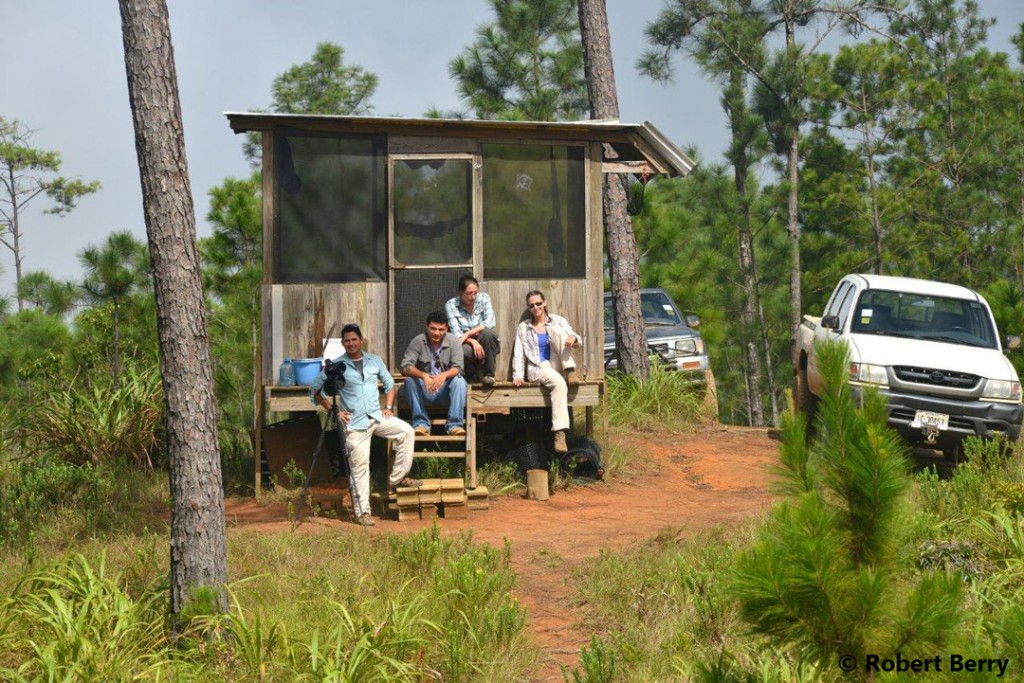 Adjacent to the tower is a screened hut called the pavilion where research and graduate student ‘hack site attendants’ escape the black flies while monitoring and caring for the young falcons during daylight hours. According to Berry, falconers in the middle-ages developed the hacking process, fledging their nestling falcons from tree mounted artificial platforms, like the hack tower, an innovative technique perfected by The Peregrine Fund to repopulate endangered raptors such as the Peregrine and Aplomado Falcons, and now for the first time Orange-breasted Falcons. Almost directly above the pavilion, the team installed a uniquely designed falcon nest box in 2012 mounted on a large secure platform designed to somewhat replicate a natural cliff site eyrie and give the occupants security from ubiquitous depredating Black Vultures. The nest box was a wild idea after B1 had attracted and appeared to be pair-bonded with a wild female they named Caya (after the Cayo District where the hack site is located) the prior year. The long shot worked! B1 and Caya raised six chicks at the hack site, three in 2013 and 2015. Caya disappeared mysteriously just before breeding season in 2016 and was replaced by a wild female, Orange 47 who was banded in Tikal Park the previous year. In 2017 B1 and Orange 47 had the usual clutch of three eggs, two which hatched and only one surviving.
Adjacent to the tower is a screened hut called the pavilion where research and graduate student ‘hack site attendants’ escape the black flies while monitoring and caring for the young falcons during daylight hours. According to Berry, falconers in the middle-ages developed the hacking process, fledging their nestling falcons from tree mounted artificial platforms, like the hack tower, an innovative technique perfected by The Peregrine Fund to repopulate endangered raptors such as the Peregrine and Aplomado Falcons, and now for the first time Orange-breasted Falcons. Almost directly above the pavilion, the team installed a uniquely designed falcon nest box in 2012 mounted on a large secure platform designed to somewhat replicate a natural cliff site eyrie and give the occupants security from ubiquitous depredating Black Vultures. The nest box was a wild idea after B1 had attracted and appeared to be pair-bonded with a wild female they named Caya (after the Cayo District where the hack site is located) the prior year. The long shot worked! B1 and Caya raised six chicks at the hack site, three in 2013 and 2015. Caya disappeared mysteriously just before breeding season in 2016 and was replaced by a wild female, Orange 47 who was banded in Tikal Park the previous year. In 2017 B1 and Orange 47 had the usual clutch of three eggs, two which hatched and only one surviving. 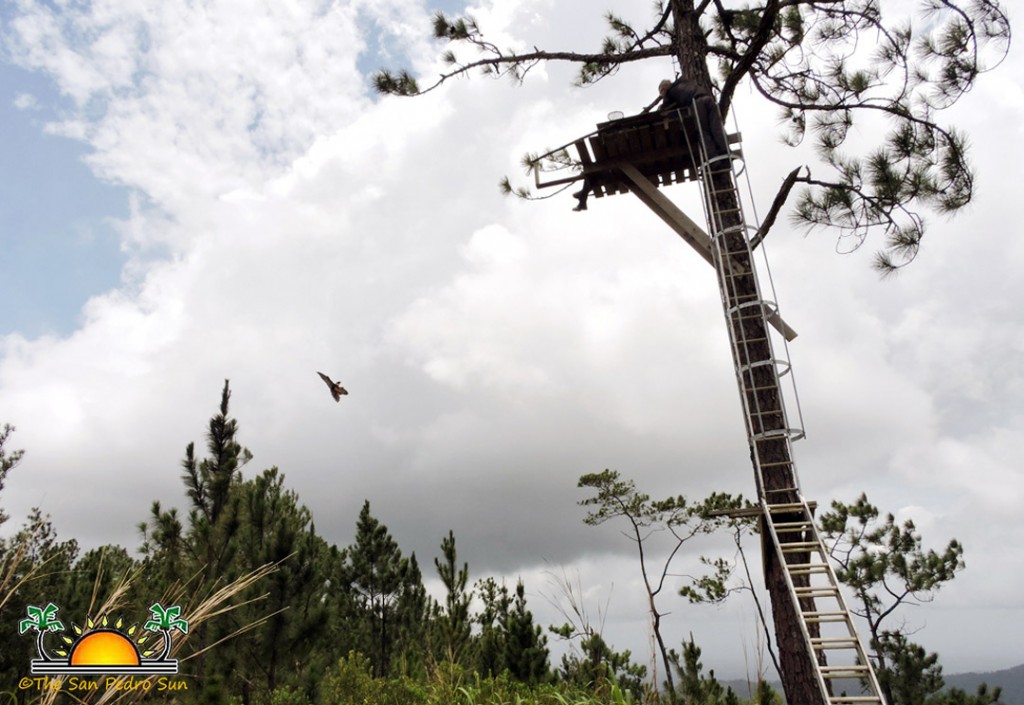 Once the annual crop of captive-bred chicks are safely situated in the hack box the team climbs the tree with the nest box and retrieves the wild-hatched chick for processing. The wild chick, a male this time, is first weighed, given a health assessment, banded as P69 (a purple color band with white alphanumeric numerals that will identify him throughout his life), and blood-feathers collected for genetic testing. Team member Audrey Martin, who is conducting next-generation genetic sequencing for her master’s degree at the University of Wyoming will use this data in her research to help answer important questions including the degree of inbreeding and relatedness of three populations, South America, Panama, and Belize/Guatemala.
Once the annual crop of captive-bred chicks are safely situated in the hack box the team climbs the tree with the nest box and retrieves the wild-hatched chick for processing. The wild chick, a male this time, is first weighed, given a health assessment, banded as P69 (a purple color band with white alphanumeric numerals that will identify him throughout his life), and blood-feathers collected for genetic testing. Team member Audrey Martin, who is conducting next-generation genetic sequencing for her master’s degree at the University of Wyoming will use this data in her research to help answer important questions including the degree of inbreeding and relatedness of three populations, South America, Panama, and Belize/Guatemala.  After processing, the wild chick is carefully placed with the captive-bred chicks at the hack site where he is cautiously accepted by his litter mates and is soon fed by his mother along with the rest of her expanded brood. Birds seem unable to count which saves them a lot of stress and worry. This first-ever innovative experiment where captive bred and wild-hatched raptors chicks are combined and raised successfully by both adult falcons and human attendants met astounding success in 2013. Both the wild parents and the hack site attendants combine forces to both feed and protect the youngsters throughout the summer until all the young learn to hunt and feed themselves prior to dispersal and independence in the fall.
After processing, the wild chick is carefully placed with the captive-bred chicks at the hack site where he is cautiously accepted by his litter mates and is soon fed by his mother along with the rest of her expanded brood. Birds seem unable to count which saves them a lot of stress and worry. This first-ever innovative experiment where captive bred and wild-hatched raptors chicks are combined and raised successfully by both adult falcons and human attendants met astounding success in 2013. Both the wild parents and the hack site attendants combine forces to both feed and protect the youngsters throughout the summer until all the young learn to hunt and feed themselves prior to dispersal and independence in the fall.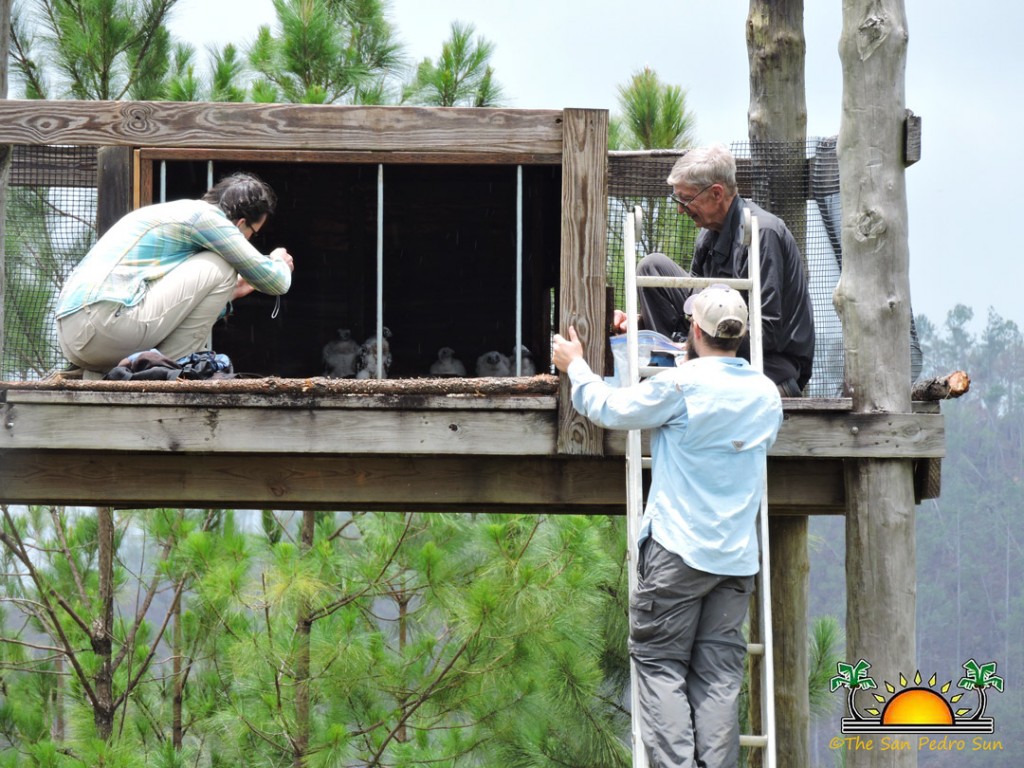 Before the juveniles attempt their first flights, they are equipped with a tiny radio transmitter that enables the team to locate them should they become lost or stranded in the deep forest canopy. Nonetheless, a third of the juveniles are lost, most falling prey to Black-and-White Hawk-Eagles when roaming the adjacent flat lands that don’t offer deep canyon escape routes. It’s a terrifying experience for both the Falcons and their attendants when an eagle dives upon its quarry from a great height! On other occasions both adult falcons and juveniles aggressively drive the eagles away, diving, striking and screaming loudly as it trespasses into their territory, braving the massive eagle as it rolls over and attempts to grasp the Falcons with its immense talons.
Before the juveniles attempt their first flights, they are equipped with a tiny radio transmitter that enables the team to locate them should they become lost or stranded in the deep forest canopy. Nonetheless, a third of the juveniles are lost, most falling prey to Black-and-White Hawk-Eagles when roaming the adjacent flat lands that don’t offer deep canyon escape routes. It’s a terrifying experience for both the Falcons and their attendants when an eagle dives upon its quarry from a great height! On other occasions both adult falcons and juveniles aggressively drive the eagles away, diving, striking and screaming loudly as it trespasses into their territory, braving the massive eagle as it rolls over and attempts to grasp the Falcons with its immense talons. B1 is the OBF team’s greatest success story and superstar of the project, not only beating the odds of an early death but fathering seven youngsters in his seven years of life. Sadly, B1 was last photographed June 11, 2017, by a remote trail camera while feeding his single progeny the day before the team arrived at the hack site. For many weeks the team despaired hoping to see him return knowing full well that he had met with foul play while hunting dutifully for his family as he had so skillfully and faithfully done in the past. As is the case with all falcon species, the male does all the hunting early in the nesting cycle while the female broods the eggs cares for the young and guards the nest. Should something happen to the male, the eggs will fail as the female is forced to hunt and the young almost assuredly will perish. Over the next few months, the hack site attendants will supplement the juvenile’s s voracious appetites with defrosted quail, taking care to avoid habituating the chicks to humans. It isn’t long before another male, Purple 29, who happens to be B1’s two-year-old son appears at the hack site and amazingly in a short few weeks seems to bond with Orange 47, helping to repel avian threats like vultures and hawk eagles and sharing hunting responsibilities. Perhaps Orange 47 understood that her mate would never return, accepting the newcomer’s assistance when he would have normally been aggressively run off as an unwelcome stranger. The team is ecstatic, although this is a bittersweet reminder how few available bachelors are out there.
B1 is the OBF team’s greatest success story and superstar of the project, not only beating the odds of an early death but fathering seven youngsters in his seven years of life. Sadly, B1 was last photographed June 11, 2017, by a remote trail camera while feeding his single progeny the day before the team arrived at the hack site. For many weeks the team despaired hoping to see him return knowing full well that he had met with foul play while hunting dutifully for his family as he had so skillfully and faithfully done in the past. As is the case with all falcon species, the male does all the hunting early in the nesting cycle while the female broods the eggs cares for the young and guards the nest. Should something happen to the male, the eggs will fail as the female is forced to hunt and the young almost assuredly will perish. Over the next few months, the hack site attendants will supplement the juvenile’s s voracious appetites with defrosted quail, taking care to avoid habituating the chicks to humans. It isn’t long before another male, Purple 29, who happens to be B1’s two-year-old son appears at the hack site and amazingly in a short few weeks seems to bond with Orange 47, helping to repel avian threats like vultures and hawk eagles and sharing hunting responsibilities. Perhaps Orange 47 understood that her mate would never return, accepting the newcomer’s assistance when he would have normally been aggressively run off as an unwelcome stranger. The team is ecstatic, although this is a bittersweet reminder how few available bachelors are out there.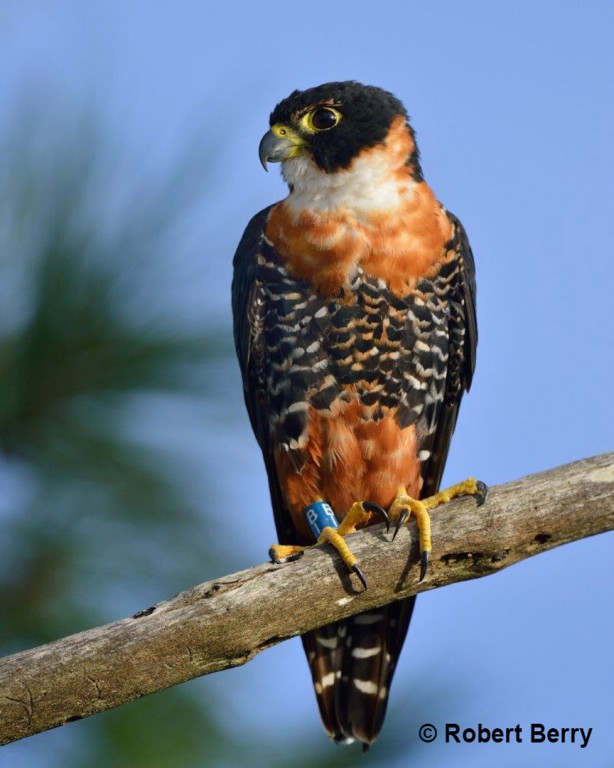 By August the white puffball chicks with big eyes and beaks have morphed into beautiful sub-adults, showing the first plumage patterns of budding adults. These handsome falcons in adult plumage sport a black mask and hood, their back is cloaked in dusky black with feathers trimmed in blue-gray that glistens in the sunlight. Their pure white throat brightly contrasts with a broad band of orange-rufous across the upper breast (crop), with a coarsely patterned black vest that adorns their breast, with rufus belly, flank and undertail, with a dark tail with striking pale white bars, arguably the most beautiful of all 39 falcon species. The juvenile plumage is not nearly as vibrant with a soft blend of buffy browns and blacks with a pale white throat. These compact aviators, the size of the common crow, prey on a wide variety of small to medium-sized birds and bats and are streamlined for high-speed dives, being the only raptor species capable of making a living hunting above the forest canopy. The female Orange-breasted Falcon is well-armed, with an unusually large beak, the largest feet of any Falcon relative to her body size, and thick powerful legs. Males have the same plumage characteristics but are half the size of their mates with normal falcon armature. Each has evolved to fulfill its niche/role in a hostile environment of eat or be eaten, the female as protector of the nest and young, the male as primary food provider for the family. They are thought to mate for life, however short, but will readily take a new mate.
By August the white puffball chicks with big eyes and beaks have morphed into beautiful sub-adults, showing the first plumage patterns of budding adults. These handsome falcons in adult plumage sport a black mask and hood, their back is cloaked in dusky black with feathers trimmed in blue-gray that glistens in the sunlight. Their pure white throat brightly contrasts with a broad band of orange-rufous across the upper breast (crop), with a coarsely patterned black vest that adorns their breast, with rufus belly, flank and undertail, with a dark tail with striking pale white bars, arguably the most beautiful of all 39 falcon species. The juvenile plumage is not nearly as vibrant with a soft blend of buffy browns and blacks with a pale white throat. These compact aviators, the size of the common crow, prey on a wide variety of small to medium-sized birds and bats and are streamlined for high-speed dives, being the only raptor species capable of making a living hunting above the forest canopy. The female Orange-breasted Falcon is well-armed, with an unusually large beak, the largest feet of any Falcon relative to her body size, and thick powerful legs. Males have the same plumage characteristics but are half the size of their mates with normal falcon armature. Each has evolved to fulfill its niche/role in a hostile environment of eat or be eaten, the female as protector of the nest and young, the male as primary food provider for the family. They are thought to mate for life, however short, but will readily take a new mate.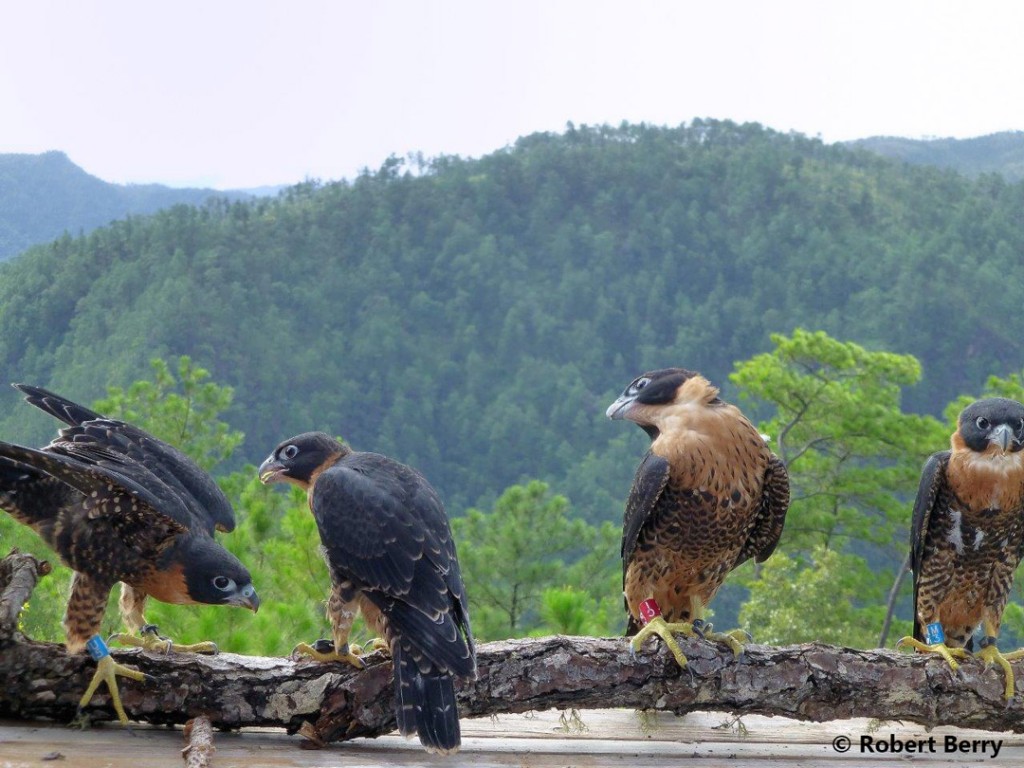 As fall arrives in the Maya Mountains the juveniles have found their independence, learning to feed themselves on a smorgasbord of diurnal migrants from the north, returning occasionally to the hack site for a free lunch but with clear evidence that they’ve adapted well to a life in the wild.
As fall arrives in the Maya Mountains the juveniles have found their independence, learning to feed themselves on a smorgasbord of diurnal migrants from the north, returning occasionally to the hack site for a free lunch but with clear evidence that they’ve adapted well to a life in the wild.
Always rare and widely distributed in Central and South America because of their specialized habitat requirements, these beautiful raptors are now absent throughout Central America. Although many countries have seemingly suitable habitat, it is a mystery why the Falcons are absent, a puzzle that Berry’s team is slowly unraveling. The question has multiple answers; a low reproductive rate, natural predation, weather, (too much or too little rainfall), DDT or other chemical contaminants, and of course human conflicts. In 2012 the International Union for Conservation of Nature (IUCN) up-listed the Orange-breasted Falcon to ‘Near Threatened based’ based on The Peregrine Fund’s research and increasing numbers of OBF records, or the absence thereof reported to Cornell Laboratory of Ornithology’s eBird by an increasing number of citizen-scientist birders. With nearly half the species nesting territories abandoned in the last two decades in their study areas, models predict extinction of the northern population within our lifetimes, if trends continue — something the OBF team is committed to preventing.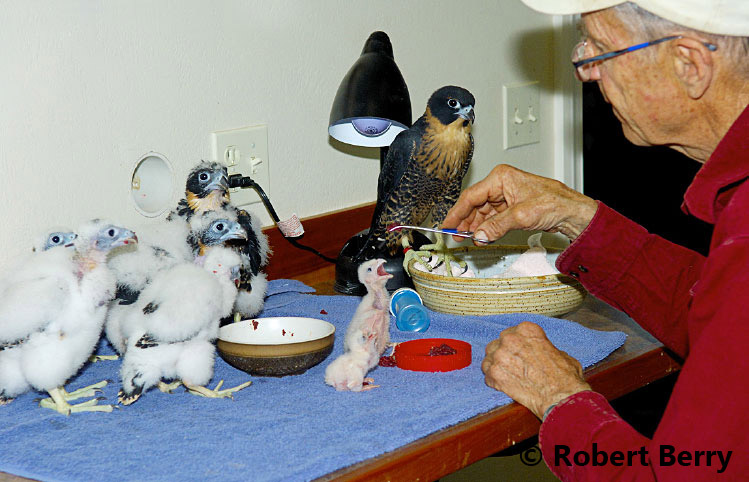 Although captive breeding is considered a last-ditch effort when it comes to restoring a threatened population, Berry believes that working with a small viable, population has been critical to the project’s measured success. Unexpected high mortality has only recently been detected from a database of less than 100 captive bred and wild OBFs banded in the last decade, inexorably linked to species emigration from the sanctuary of their mountain homes for easier hunting opportunities in the lowlands and cities at their peril. Berry also stated that captive breeding and restoration with unrelated individuals is key to increase genetic diversity and fitness in the small population. He says that fitness improves the odds that the best genes will be passed to future generations. Berry’s captive-bred falcons from Panama are surviving and breeding with wild OBFs, having fledged nine youngsters in 2013 and 2015 alone, compared to only eight produced by wild pairs in the Mountain Pine Ridge. Although these numbers are disturbing small, there is cause for optimism and a brighter future for the OBF as an icon for all raptors. Education and conservation efforts by local conservation groups, eco-lodges, government agencies, and individuals are all key to creating awareness and give meaning to the vital role raptors play in the web of life, along with their practical benefits in pest control and eco-tourist dollars that depend upon a healthy ecosystem.
Although captive breeding is considered a last-ditch effort when it comes to restoring a threatened population, Berry believes that working with a small viable, population has been critical to the project’s measured success. Unexpected high mortality has only recently been detected from a database of less than 100 captive bred and wild OBFs banded in the last decade, inexorably linked to species emigration from the sanctuary of their mountain homes for easier hunting opportunities in the lowlands and cities at their peril. Berry also stated that captive breeding and restoration with unrelated individuals is key to increase genetic diversity and fitness in the small population. He says that fitness improves the odds that the best genes will be passed to future generations. Berry’s captive-bred falcons from Panama are surviving and breeding with wild OBFs, having fledged nine youngsters in 2013 and 2015 alone, compared to only eight produced by wild pairs in the Mountain Pine Ridge. Although these numbers are disturbing small, there is cause for optimism and a brighter future for the OBF as an icon for all raptors. Education and conservation efforts by local conservation groups, eco-lodges, government agencies, and individuals are all key to creating awareness and give meaning to the vital role raptors play in the web of life, along with their practical benefits in pest control and eco-tourist dollars that depend upon a healthy ecosystem. To see an Orange-breasted Falcon in the wild is a breathtaking sight, and spotting one is relatively common in towns and cities in the Cayo district during the fall and winter months, where they feed on feral pigeons and collared doves. With binoculars, one can usually spot a colored band on the bird’s leg. Captive-bred females carry red bands, males blue, while wild-hatched females have orange bands and males have purple, all with bold white letters and numerals. The OBF team encourages that all sightings and band information be reported either directly to the popular eBird app or to citizen-scientist birder who can. If you are not able to read the band number, just the color of the band and which leg it is on helps the team identify the bird and adds to their knowledge. There are three popular birding locations in all Central America where Orange-breasted Falcons are predictably seen; Tikal National Park, Guatemala, Thousand Foot Falls Reserve in the Mountain Pine Ridge and Black Rock Lodge along the Macal River. Quality accommodations and guide services (recommended) are offered by Hidden Valley Inn & Reserve in the Maya Mountains and nearby Black Rock Lodge, along with many other fine eco-lodges in the area.
To see an Orange-breasted Falcon in the wild is a breathtaking sight, and spotting one is relatively common in towns and cities in the Cayo district during the fall and winter months, where they feed on feral pigeons and collared doves. With binoculars, one can usually spot a colored band on the bird’s leg. Captive-bred females carry red bands, males blue, while wild-hatched females have orange bands and males have purple, all with bold white letters and numerals. The OBF team encourages that all sightings and band information be reported either directly to the popular eBird app or to citizen-scientist birder who can. If you are not able to read the band number, just the color of the band and which leg it is on helps the team identify the bird and adds to their knowledge. There are three popular birding locations in all Central America where Orange-breasted Falcons are predictably seen; Tikal National Park, Guatemala, Thousand Foot Falls Reserve in the Mountain Pine Ridge and Black Rock Lodge along the Macal River. Quality accommodations and guide services (recommended) are offered by Hidden Valley Inn & Reserve in the Maya Mountains and nearby Black Rock Lodge, along with many other fine eco-lodges in the area.
Berry considers 2017 a modestly successful year for the OBF. The team estimates that as many as 13 OBFs may have fledged this year from the Mountain Pine Ridge and close environs, nine from wild pairs and four captive-bred. Two may have fledged in the southern mountains and undoubtedly a few more. The preservation of these endangered falcons is an ongoing challenge for the dedicated team of the OBF Project and would not be possible without the invaluable assistance of Belizean birders and guides, along with local cooperators. The current team consists of Team Leader Matthew Allshouse, Hack Site Supervisor Audrey Martin, Field assistants Bryce Robinson and Sherman Cawich, Consulting Naturalist Roni Martinez, Molecular Biologist Jeff Johnson and Program Advisor Scott Newbold. Previous birders, guides and team members include Yeray Seminario, Angel Muela, Marta Curti, Jonathan Urbina, Rony Jobel and Sarah Mann who founded The Belize Raptor Center with a mission to educate Belize’s youth about raptors, and many others who contribute their time and knowledge by reporting many OBF records, many with photos to eBird.
The preservation of these endangered falcons is an ongoing challenge for the dedicated team of the OBF Project and would not be possible without the invaluable assistance of Belizean birders and guides, along with local cooperators. The current team consists of Team Leader Matthew Allshouse, Hack Site Supervisor Audrey Martin, Field assistants Bryce Robinson and Sherman Cawich, Consulting Naturalist Roni Martinez, Molecular Biologist Jeff Johnson and Program Advisor Scott Newbold. Previous birders, guides and team members include Yeray Seminario, Angel Muela, Marta Curti, Jonathan Urbina, Rony Jobel and Sarah Mann who founded The Belize Raptor Center with a mission to educate Belize’s youth about raptors, and many others who contribute their time and knowledge by reporting many OBF records, many with photos to eBird.
The Peregrine Fund OBF team would like to thank George and Melina Headley, owners of Bull Run Overseas Ltd. for their friendship and invaluable logistical support, without which the OBF project would not be possible. They would like to dedicate this article and their restoration efforts to the memory of George Headley who passed away in November 2017. They thank Trevor Roe and the Roe family, and the many folks at Hidden Valley Inn for their years of support. The Peregrine Fund OBF team is also grateful to Dr. Wilbur Sabido, Chief Forest Officer, Belize Forest Department and his assistants for their timely support with permits that enables their programs. They also thank Dr. Miguel DePaz, Director, and Dr. Edward Tesecum of the Belize Agricultural Health Authority, and their assistant Melody Robateau for their patience, understanding, and guidance for the safe import of captive-bred falcons and for providing the necessary health certificates for their imports and exports. Appreciation also goes to Freddie Pineda, Isaias Morataya, Diego Cruz, Cameron Boyd and Giovanni Fernandez, owner, and manager of Black Rock Lodge for their able assistance and interest in the OBF project, Darrel Smith, Ian Anderson, Ella Baron of Caves Branch Jungle Lodge and Lee Jones. In Guatemala, they are indebted to Dimos Perez Rivera, Aquiles Hernandez, and Samuel Ortega for their help in facilitating their continued surveys and banding both within and outside Tikal Park. Their continued work in Guatemala would not be possible without the generous support provided by Robert and Jon Cahill of Community Cloud Forest Conservation, Mirta Cano and Julio Madrid of CONAP, and Javier Rivas, Professor at the School of Biology, Universidad de San Carlos de Guatemala, and Eduardo Inigo-Elias, Senior Research Associate at the Cornell Lab of Ornithology. The OBF team is indebted to the Lopez family of La Cruce dos Aquados village for providing friendship and logistical assistance each time they visit the Petén region. Finally, they thank the Wolf Creek Charitable Foundation for their generous financial support.

If you would like to learn more about this project and how you can help, please visit http:/www.bit.ly/OBFalcon. For identification assistance (OBF versus Bat Falcon) you can visit www.birds.cornell.edu/obf
For more stories about the Orange-breasted Falcon and photos please visit our sister website at www.mybeautifulbelize.com


